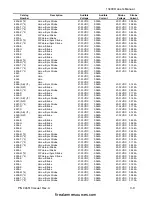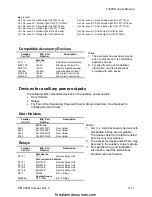
13400 Owner’s Manual
P/N 446613 Issue I Rev. A
G-1
Glossary
Alarm Signal. A signal indicating an emergency requiring immediate action, such as an
alarm for fire from a manual station, a waterflow alarm, or a automatic smoke detector.
Alarm Silence Inhibit. A option that prevents a human operator from silencing the
notification appliances for a preset period of time.
Alarm System. A combination of compatible initiating devices, control panels, and
notification appliances designed and installed to produce an alarm signal in the event of
a fire.
Alarm Verification. A preset option that causes the panel to verify alarms originated by
smoke detectors before indicating an alarm.
Annunciator. A remotely-located, electrically powered display, separate from the
control panel, containing LEDs or lamps to indicate the states of the fire alarm system.
Audible Signal. An audible signal is a sound made by one or more audible notification
appliances, such as bells or horns, in response to the operation of an initiating device.
Authority Having Jurisdiction (AHJ). The organization, office, or individual
responsible for “approving” equipment, installation or procedure.
Auto-Silence. The capability of a panel to automatically silence the notification
appliances after a preset period of time.
Auxiliary Relays. Control relays that energize only during alarm conditions that are
used to either apply power to or remove power from other equipment during an alarm
condition.
Class A Circuit. An initiating device or notification appliance circuit within which all
components remain fully functional, even though a single open or ground exists in the
circuit.
Class B Circuit. An initiating device or notification appliance circuit within which some
or all components may be disabled with a single open or ground exists in the circuit.
Detector - Smoke, Ionization Type. A detector employing the principle of smoke’s
effect on an electrical current flowing in an ionized air chamber.
Detector - Smoke, Photoelectric Type. A detector employing the photoelectric
principle of reflection or obstruction of light by smoke.
End Of Line (EOL). A device used to terminate a supervised circuit.
General Alarm. A term usually applied to the simultaneous operation of all the
notification appliances on a system.
firealarmresources.com

























